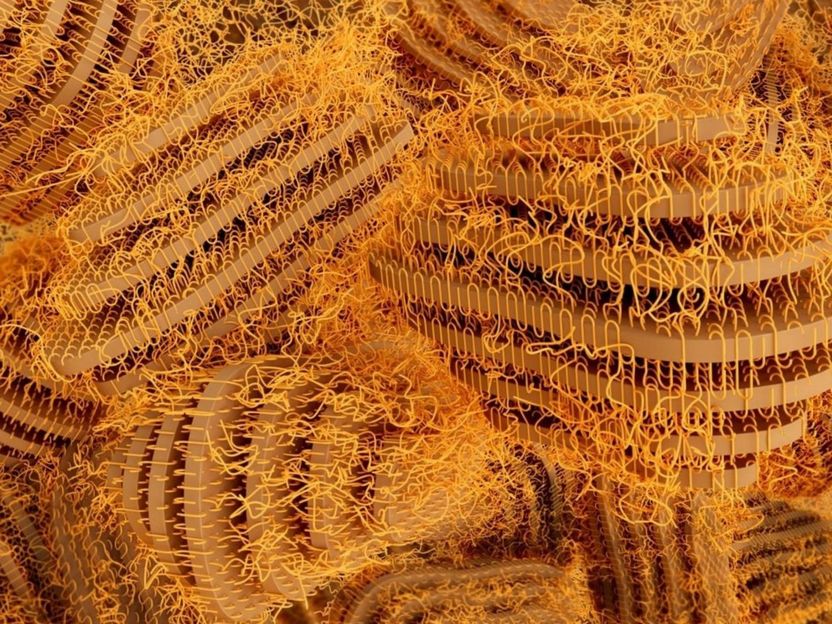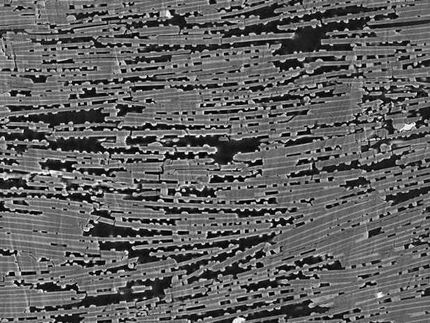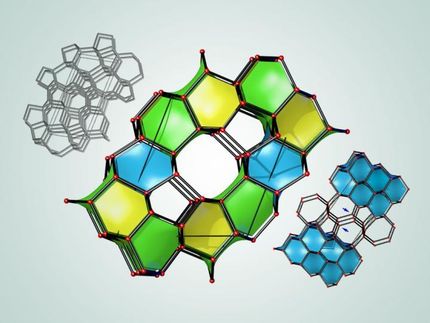Two-phase material with surprising properties
Advertisement
Microstructure and macroscopic electro-mechanical properties are closely coupled in so-called ferroelectric polymers. An explanation for the high temperature dependence of this coupling has now been found at TU Wien.

Microscopic polymer structures
Technische Universität Wien
In certain materials, electrical and mechanical effects are closely linked: for example, the material may change its shape when an electrical field is applied or, conversely, an electrical field may be created when the material is deformed. Such electromechanically active materials are very important for many technical applications.
Usually, such materials are special, inorganic crystals, which are hard and brittle. For this reason, so-called ferroelectric polymers are now being used. They are characterised by the fact that their polymer chains exist simultaneously in two different microstructures: some areas are strongly ordered (crystalline), while disordered (amorphous) areas form in between. These semicrystalline composites are electromechanically active and therefore combine electrical and mechanical effects, but at the same time they are also flexible and soft. At TU Wien, such materials have now been studied in detail – with surprising results: above a certain temperature, the properties change dramatically. A research team from TU Wien in cooperation with research groups from Madrid and London has now been able to explain why this happens.
From micro-sensors to smart textiles
"If you can control the mechanical behaviour of a material with the help of electric fields, you can use it to build tiny sensors, for example," says Prof. Ulrich Schmid from the Institute of Sensor and Actuator Systems at TU Wien. "This is also interesting for atomic force microscopes, where you set a tiny tip in vibration to scan a surface and generate an image."
The field of application of such materials can be expanded dramatically if it is possible to induce such electromechanical properties not only in rigid materials, but also in flexible, soft materials. On the one hand, flexible materials have a completely different vibration behaviour, which can be exploited in the construction of tiny sensors. On the other hand, such materials also open up completely new possibilities – such as smart textiles, flexible energy storage or for integrated energy harvesting.
"Solids can be crystalline, in which case the atoms are arranged in a regular lattice, or they can be amorphous, in which case the individual atoms are randomly distributed," explains Jonas Hafner, who is working on this research project as part of his dissertation. "The special thing about the material we studied is that it can be both at the same time: It forms crystalline regions, and in between the material is amorphous."
The crystals are responsible for the electromechanical properties of the material, the amorphous matrix holds the tiny crystals together, overall creating a very soft, flexible material.
Too much heat
In order to be able to further develop and improve such materials, the research team first investigated their basic physical properties. During their investigations, they came across a surprising phenomenon: the ferroelectric polymers, which consist of a combination of crystalline and amorphous areas, change their microscopic composition at a certain temperature – which has surprising effects on the macroscopic electromechanical behaviour.
Normally, the electromechanical properties of a material only disappear when a very high temperature causes such large oscillations at the atomic level, that the electrical order in the material disappears completely. This critical temperature is called the "Curie temperature". But in the case of the material now being studied, things are more complicated: "In our case, the electromechanical properties of the tiny crystals remain. Microscopically, the crystals are still electroactive, but on the macroscopic level, this electroactive behaviour disappears," says Jonas Hafner.
Lost contact between the crystal grains
The team was able to explain how this effect occurs: As the temperature rises, the proportion of amorphous areas of the polymer increases, and at a certain point the tiny crystals lose direct contact among each other. This means that mechanical forces can no longer be transferred from one of the tiny crystals to the next, because they are all completely embedded in a damping amorphous matrix. This dramatically changes the mechanical and electromechanical behaviour of the material.
"Only if we understand these fundamental effects we can explain how microscopic and macroscopic properties correlate in such materials," says Ulrich Schmid. "We are working with numerous project partners who then use such materials – in atomic force microscopes, in sensors, in chips. There are numerous potential applications for this exciting material phase."
Original publication
J. Hafner et al.; "Multi-scale characterisation of a ferroelectric polymer reveals the emergence of a morphological phase transition driven by temperature"; Nature Communications; volume 12, 152 (2021).
J. Hafner et al.; "Large bias-induced piezoelectric response in the ferroelectric polymer P(VDF-TrFE) for MEMS resonators"; Mater. Res. Lett.; 2021, 9, 4, 195–203.






























































